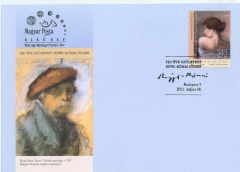ARTS 2011 József Rippl-Rónai were born 150 years ago
József Rippl-Rónai (Kaposvár, 23 May 1861 – Kaposvár, 25 November 1927) Hungarian painter and graphic artist. He was a chemist’s assistant and then obtained a master certificate in pharmacy in Budapest. In 1882 he worked as a private tutor and took drawing classes. From 1884 he studied at the Academy of Art in Munich and in 1887 in Paris with Mihály Munkácsy later becoming his assistant. At the beginning the effect of Munkácsy could be seen in his work, but during his stay in France he got acquainted with new styles and trends. After returning home in 1902 he settled in Kaposvár. He was a founding member of the Hungarian Group of Impressionists and Naturalists and also took part in the Nyugat (West) movement. After from painting, he was also involved in the design and production of glass windows. In 1912 it was he who made the large glass window in the Ernst Museum. When World War I broke out he was detained in Paris and interned, he returned home to Kaposvár in 1915. He is regarded as the best Hungarian representative of post-impressionism and Art Nouveau. His painting is characterised by a rich world of colour, stylised lines and decorative features. At the beginning of the 1900s he painted pastels. He established a unique style, which he called “kukoricás” (maize-like): he applied the paints onto the canvas in a cotton wool, patchy manner. In his honour a Rippl-Rónai art award was set up in Kaposvár and in 1978 the Ripple-Rónai Commemorative Museum was opened. (Source: hu.wikipedia.org)
| Type | First Day Cover |
| Short description | In the special stamp series entitled Arts Magyar Posta present the works of famous Hungarian artists. On one of the stamps in the series in 2011 a detail from József Koszta’s Small girl with geranium (around 1917; Hungarian National Gallery) can be seen |
| Printing Office | Állami Nyomda |
| Issue year | 2011 |
| Issue time | 2011. május 18. |
| Theme | arts |
| Designer | Imre Benedek |
| Stamped/Uncanceled | cancelled |


